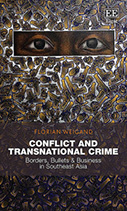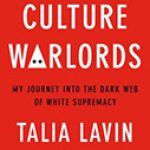Conflict and Transnational Crime: Borders, Bullets and Business in Southeast Asia

Author: Florian Weigand
Publisher: Edward Elgar, 2020. 176 pages.
Reviewer: Neil Boister ǀ March 2022
The conflict–crime nexus has drawn scholarly attention in recent years with notable contributions including Christine Jojarth’s Crime, War and Global Trafficking (2009) and Julia Muraszkiewicz’s edited collection Human Trafficking in Conflict: Context, Causes and the Military (2021). Security organizations have been prone to exaggerate the nexus. There has been a significant rise for example in the number of UN Security Council statements, resolutions and debates containing reference to organized crime, with official statements about the overlap for example between trafficking and terrorist organizations becoming commonplace. As De Boer and Bosetti note:
The explanation with regard to the increased prevalence of the “crime-conflict nexus” during the 1990s was relatively simple. The end of the Cold War, with the resulting drop in financial support from superpowers for armed actors fighting “proxy wars”, propelled armed actors (particularly non-state actors) to tap into other sources of conflict finance. This impetus, combined with globalization and modern technologies, provided new opportunities for local conflict actors to connect with criminal networks and illicit markets, thereby, facilitating access to supply chains that could fund and equip armed actors.[1]
Florian Weigand’s research focuses on the areas in South East Asia associated with transnational crime where protracted armed conflicts involving state and nonstate actors are being fought. Based on more than 100 interviews with members and supporters of nonstate armed groups, smugglers, government officials, civil society activists, victims of conflict, and people smuggled or trafficked, Weigand’s book undermines the simplistic criminogenic explanation that these nonstate actors foster crime and benefit directly from it.
The book is a record of research undertaken into smuggling in four different conflict areas – the border regions of Thailand-Malaysia, Myanmar-China, Bangladesh-Myanmar and Indonesia–Philippines–Malaysia. Each region is thoroughly explored with compelling accounts of the background to conflict in the region, the different players including state and nonstate organizations and their structures and objectives, and a brief survey of the local smuggling economy. Although the picture varies from region to region, Weigand shows that the common narrative that insurgents and rebels are the main drivers of smuggling activities in these zones is fallacious; more often than not, state actors play the most prominent role in smuggling networks in these zones. This seems counterintuitive, given the state has set the scene by either declaring certain goods illegal or imposing high tariffs or taxes on their importation. However, as he explains, nonstate armed groups often lack territorial control and have legitimacy deficits which make it difficult for them to undertake activities that may jeopardize their relationship with the local population. In contrast, state actors are able to monopolize the cross-border traffic and push out competitors. Smuggling frequently becomes an important source of revenue for local officials who benefit through taxing this traffic. Only smuggling that falls outside the control of the state is regarded as subversive.
Weigand reveals that the standardized generic notion of a nonstate actor benefiting from trafficking, particularly drug trafficking, is based on thin or no evidence; heterogeneity is much more common than homogeneity. Different incentives, different levels of territorial control, different concerns about legitimacy and accountability, all lead to different approaches from nonstate actors for engagement in smuggling. Some organizations stay completely out of the local smuggling economy whilst others engage in the smuggling of some substances but not others. Only those organizations engaged in global terrorism and which receive outside support, can really afford to ignore the destabilizing effect they may have on the local smuggling economy. But so too can rulers unconcerned about local legitimacy. Weigand draws many other unanticipated conclusions based on the evidence he gathers. Readers will be surprised to find, for example, that the idea of smugglers crossing remote terrain belies the reality that most smuggling occurs in areas with good infrastructure. Conflict zones may be the sources of illicit goods like drugs, but they are frequently avoided by traffickers because of the risk associated with crossing them. The book is full of other little gems, including the paradox that in countries imposing heavy penalties on drug trafficking including death, local officials are almost completely complicit with the smuggling of drugs.
The question that Weigand poses but does not fully answer is why state authorities become so heavily involved in smuggling when they have the option of taxation of the licit trade. He suggests that control of disputed territory and justification of the presence of security forces may be the real goal; state actors can always blame the illicit traffic on nonstate actors while benefiting from it on the side. Indeed, he suggests that it is this classification of behaviour as criminal that lies at the heart of the crime–conflict nexus, and creates the many myths surrounding it. In this engaged and open-minded study, Florian Weigand does us all a favor by exposing how shaky assumptions about the crime conflict nexus are.
Neil Boister, Canterbury, NZ
[1] United Nations University Centre for policy research, ‘The crime – conflict “nexus”: state of the evidence’, UNU-CPR occasional paper five, July 2015, available at http://collections.unu.edu/eserv/unu:3134/unu_cpr_crime_conflict_nexus.pdf

